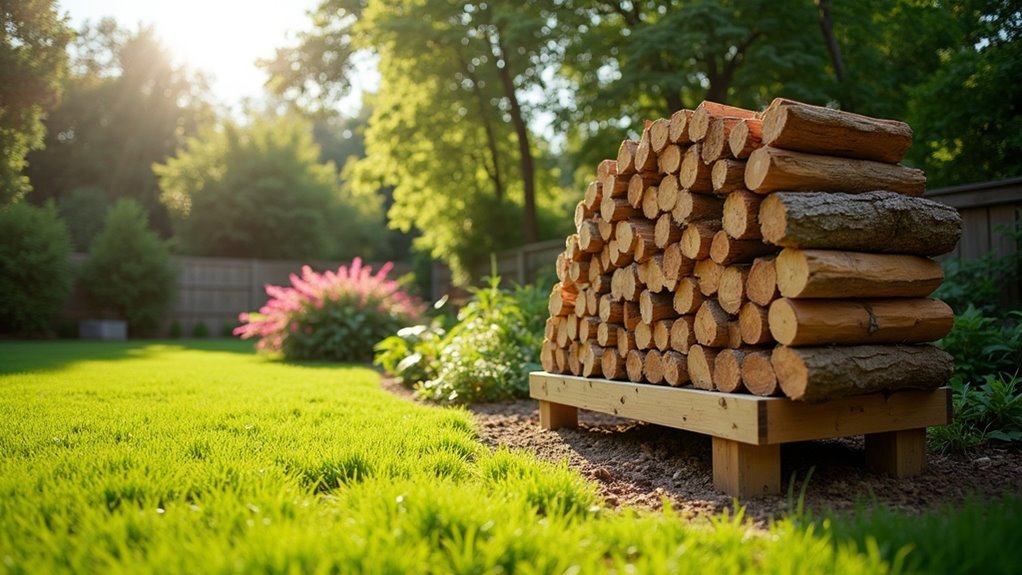You can create a termite-resistant landscape by maintaining at least one meter distance between vegetation and your home’s foundation. Plant natural deterrents like lemongrass, eucalyptus, and marigolds that repel termites with their oils and scents. Install proper drainage systems to eliminate moisture accumulation, store firewood 20 feet away from your house, and remove wood debris promptly. Combine these strategies with physical barriers like stainless steel mesh for thorough protection that’ll safeguard your property investment.
Understanding the Termite Threat in Your Landscape

Your landscape can become a termite highway leading straight to your home’s foundation. Poor landscaping choices create perfect conditions for these destructive pests.
Moisture accumulation from inadequate drainage transforms your yard into termite paradise, while rotting wood from tree stumps and dead plants provides irresistible food sources nearby.
Standing water and decomposing organic matter create the perfect storm for termite infestations in your backyard.
Wood mulch and untreated timber positioned close to your foundation fundamentally roll out the red carpet for termite colonies. These materials don’t just attract termites—they sustain entire populations that’ll eventually target your home’s structure.
However, strategic landscape choices can prevent infestations. Plant natural deterrents like garlic, mint, and vetiver grass around your property.
Remove debris regularly, trim vegetation away from your foundation, and eliminate moisture problems. Understanding these landscape-termite connections helps you design outdoor spaces that protect rather than endanger your home.
Strategic Plant Selection for Natural Termite Deterrence
While conventional termite control relies on chemical treatments, strategic plant selection offers a natural defense system that protects your home year-round.
Termite-resistant plants create an effective landscape barrier through their natural repelling properties and moisture management capabilities.
Your termite deterrence strategy should include these powerful plant choices:
- Lemongrass and catnip – contain oils that actively repel subterranean termites
- Eucalyptus, lavender, and marigolds – produce strong scents that naturally deter pests
- Garlic and mint – release compounds lethal to termites within 24 hours
- Vetiver grass – features a deep root system with nootkatone, preventing soil erosion while repelling insects
- Strategic spacing – maintain one meter distance from your home’s foundation for maximum effectiveness
This natural approach transforms your landscape into a protective barrier against termite infestations.
Proper Spacing and Foundation Protection Techniques

Beyond selecting the right plants, you must implement proper spacing and foundation protection techniques to create an impenetrable defense against termite invasion.
Maintain at least one meter between trees, shrubs, and your house to prevent termite infestation from attractive vegetation. Elevate nonstructural wood six inches and structural wood eight inches above soil to eliminate direct contact.
Keep vegetation one meter from your foundation and elevate all wood materials above ground level to block termite access.
Install effective drainage systems with gutters and downspouts directing water away from your foundation, preventing moisture accumulation that attracts termites. Strategic landscaping placement away from your foundation reduces conducive environments for termite colonies.
Deploy physical barriers using stainless steel mesh or plastic sheets around your foundation perimeter, blocking termite access routes. Regular inspection of these prevention techniques guarantees long-term effectiveness, protecting against costly structural damage.
Moisture Management and Drainage Solutions
You’ll need to establish effective water drainage systems around your home’s foundation to keep termites at bay.
Poor drainage creates the damp conditions that attract these destructive pests, making proper water management essential for prevention.
Proper Water Drainage
Since termites thrive in moisture-rich environments, establishing effective water drainage around your property becomes one of your most powerful defenses against infestation.
Proper drainage eliminates standing water that attracts these destructive pests to the foundation of your home.
Essential landscaping tips for preventing termite infestations through effective drainage include:
- Keep gutters and downspouts clear of debris to direct rainwater away efficiently
- Install downspout extenders channeling water at least 6 feet from your foundation
- Grade soil around your home to slope away from structures
- Conduct regular inspections for plumbing leaks and drainage problems
- Maintain your drainage system to prevent moisture accumulation near wooden structures
These proactive measures greatly reduce termite-attracting conditions around your property.
Eliminating Excess Moisture
While proper drainage forms the foundation of moisture control, eliminating excess moisture requires a thorough approach that targets all potential water sources around your property.
You’ll need extensive drainage management strategies that address standing water accumulation near your foundation. Install downspout extenders directing rainwater 5-10 feet away from your home’s perimeter.
Regular maintenance of irrigation systems prevents overwatering that creates favorable conditions for termite infestation.
Implementing strategic landscaping techniques means maintaining at least one meter between large-rooted plants and your house structure. This spacing helps control soil moisture levels effectively.
Monitor and repair any plumbing leaks immediately, as even minor water sources attract termites.
Wood Storage and Debris Removal Best Practices

You’ll considerably reduce termite risks by implementing smart wood storage and debris removal practices around your property.
Proper firewood positioning and consistent yard cleanup create barriers that discourage these destructive pests from establishing colonies near your home.
Let’s examine the specific methods that’ll keep your outdoor spaces termite-resistant.
Proper Firewood Storage Methods
Although termites can infiltrate your property through various entry points, improper firewood storage creates one of the most preventable pathways for these destructive pests.
You’ll dramatically reduce potential termite infestations by implementing smart storage strategies that eliminate attractive conditions for these wood-destroying insects.
Follow these essential firewood storage guidelines:
- Store your firewood at least 20 feet from your home’s foundation to create a protective barrier
- Elevate stored firewood using racks or pallets to prevent moisture accumulation underneath
- Choose only seasoned firewood that’s dried for six months, making it less appealing to termites
- Avoid stacking firewood directly against your house walls or structure
- Remove wood debris like fallen branches and stumps to eliminate termite habitats
These practices protect your property investment.
Yard Debris Elimination Strategies
Beyond proper firewood storage, maintaining a clean yard free of wood debris represents your next line of defense against termite invasion.
You’ll need to eliminate yard waste that attracts these destructive pests to your property. Remove rotting stumps and dead trees promptly, as decomposing organic matter creates considerable termite attraction.
Don’t let fallen branches and dead plants accumulate, since they’ll establish habitats for termite infestation. Clear away unnecessary wood debris regularly to prevent termites from establishing colonies near your home.
When planning your landscaping, avoid untreated wood materials that provide ready food sources. Instead, choose treated lumber or stone alternatives.
Maintaining a tidy yard through consistent debris removal greatly reduces termite risks and protects your property investment.
Creating Effective Physical and Chemical Barriers
When it comes to protecting your home from termite invasions, establishing robust physical and chemical barriers forms your first line of defense.
These proven methods work together to prevent termite infestation by blocking access points and creating hostile environments for subterranean termites.
Effective barrier implementation includes:
Combining physical and chemical barriers creates the most comprehensive defense against termite invasion and structural damage.
- Installing stainless steel mesh or plastic sheets around your foundation during the construction phase
- Applying professional soil treatment with insecticides to create protective zones
- Adding metal termite shields beneath wooden structures for termite-resistant protection
- Confirming proper drainage systems that eliminate moisture accumulation
- Scheduling regular inspections to maintain barrier integrity and identify vulnerabilities
You’ll maximize protecting your home by combining both physical barriers and chemical barriers.
This dual approach guarantees thorough coverage against termite activity while addressing different invasion methods these destructive pests typically employ.
Maintenance Schedules for Long-Term Protection
While physical and chemical barriers provide essential initial protection, your termite defense system requires consistent maintenance to remain effective over time.
Develop a thorough maintenance schedule that includes regular landscaping inspections for mud tubes and hollow-sounding wood near your foundation. Remove dead plants, tree stumps, and wood debris promptly to eliminate food sources.
Keep gutters clean and functioning to prevent moisture accumulation that attracts termites. Trim vegetation to maintain 2-3 feet clearance from your home’s foundation.
Schedule annual inspections with professional pest control services to identify vulnerabilities early. This proactive termite control approach guarantees long-term protection and helps prevent extensive damage to your property through systematic monitoring and maintenance.
Professional Assessment and Monitoring Systems
Although DIY prevention methods form the foundation of termite control, professional assessments bring specialized expertise that can identify vulnerabilities you might overlook.
These experts evaluate your property’s specific termite entry points and recommend tailored preventive measures for your unique landscape.
Professional monitoring systems provide extensive protection through:
- Bait stations and inspection traps – Enable continuous surveillance and early detection of termite activity
- Annual inspections – Keep you ahead of potential infestations before costly damage occurs
- Moisture monitoring systems – Manage humidity levels that attract termites to your property
- Landscaping materials evaluation – Confirm plant selections don’t create termite-friendly environments
- Customized intervention strategies – Address specific risks based on your property’s layout and conditions
These systems work together to prevent termite infestations effectively.
Frequently Asked Questions
What Is the Best Ground Cover to Avoid Termites?
You’ll find vetiver grass offers the best termite protection since it contains nootkatone, which scientifically repels subterranean termites. It’s hardy, thrives in various climates, and provides reliable ground cover that’s proven effective against these destructive pests.
What Plant Keeps Termites Away?
You’ll find catnip works exceptionally well since it contains nepetalactone, which effectively repels subterranean termites. Lemongrass and vetiver grass also deter termites naturally through their citronella and nootkatone compounds respectively.
What Do You Put Around Foundation to Prevent Termites?
You’ll want to install stainless steel mesh barriers and create a 12-inch clearance between soil and wood. Apply chemical soil treatments around your foundation and use termite-resistant materials like pressure-treated lumber.
How to Keep Your House Termite Free?
You’ll keep your house termite-free by regularly inspecting for mud tubes, maintaining dry conditions, sealing cracks with caulking, removing wood debris, and planting termite-repelling vegetation like catnip around your property.
In Summary
You’ve learned the essential strategies to protect your property through smart landscaping choices. By selecting termite-resistant plants, maintaining proper spacing, managing moisture effectively, and implementing regular maintenance schedules, you’re creating a powerful defense system. Don’t forget to establish monitoring protocols and consider professional assessments. Your proactive approach to landscape design will greatly reduce termite risks and protect your home’s foundation for years to come.





Leave a Reply